TRANS CANADA / AIR CANADA – A History of Canada’s National Airline 1937 – 1983 by Henry Tenby
By Henry Tenby, this article appeared in the Spring 1984 issue of the Captain’s Log, the quarterly publication of the World Airline Hobby Club (now rebranded the World Airline Historical Society).
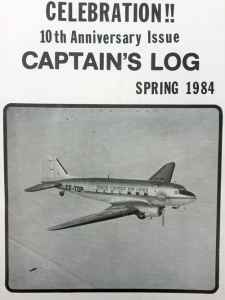 Canada’s national airline, Trans Canada Air-lines was born on April 10, 1937, when the TCA creation bill was given royal assent. On September 1, 1937, the airline made its debut flight with a one hundred and thirty mile airmail flight between Vancouver, B.C. and Seattle, Washington.
Canada’s national airline, Trans Canada Air-lines was born on April 10, 1937, when the TCA creation bill was given royal assent. On September 1, 1937, the airline made its debut flight with a one hundred and thirty mile airmail flight between Vancouver, B.C. and Seattle, Washington.
A Lockheed 10A Electra was used for this historic fight. At the time, TCA owned only three Lockheed 10As and one Stearman biplane. (These aircraft had previously been owned by Canadian Pacific Air Lines.) New equipment was ordered and larger Lockheed 14s were added by December of 1938, giving TCA 10 Lockheed 14s and 10 Lockheed 10s in its fleet. By October 1938, a daily airmail service for the Postal Department had been established between Montreal-0ttawa-Toronto-winnipeg.
With the outbreak of World War II in l939, the airline operated quite sluggishly as passengers, crew members and ground support people had to devote more time to the war effort. On April 1, 1939, transcontinental revenue passenger service was initiated between Vancouver and Montreal utilizing a Lockheed 14 and a Toronto-New York service was started in May of 1941. During the war, the airline was in a holding pattern of expansion but it also saw TCA’s first European service. To support the Canadian Armed Forces in Europe. In 1943, an Avro Lancaster (called a Lancastrian by TCA) began to fly a war-time service between Montreal and Prestwick.
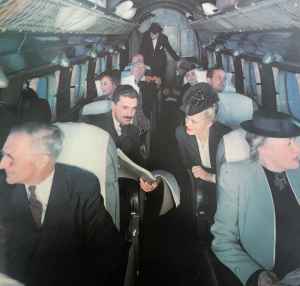
Early Trans Canada Air Lines Lockheed Lodestar interior circa 1940s, in colour. This aircraft flew domestic routes from January 7, 1941, to October 8, 1949.
TCA really began to expand after the war as they received a number of surplus and new DC-3s and Lancastrians, which cold hold ten passengers and 9,000 pounds of freight. In 1947, the Lancastrians were phased out and replaced with Canadian DC-4M2 North Stars. The North Star was the first pressurized, long ranged four engine airliner to go into service with TCA and operated its first revenue flight on April 15, 1947.
Throughout their career, the North Stars served the Montreal-London route, the cross Canada “milk run” which served small town routes and were also widely used on Caribbean routes. The DC-3 deserves honorable mention as it was the strong workhorse of TCA’s domestic route network up until her retirement in the early 1960s. By 1948, all the Lockheed 14s and the Lancastrians had been retired and the airline was gearing up for the next decade.

“Specify TCA International Air Cargo” by North Star as advertised in March, 1951.
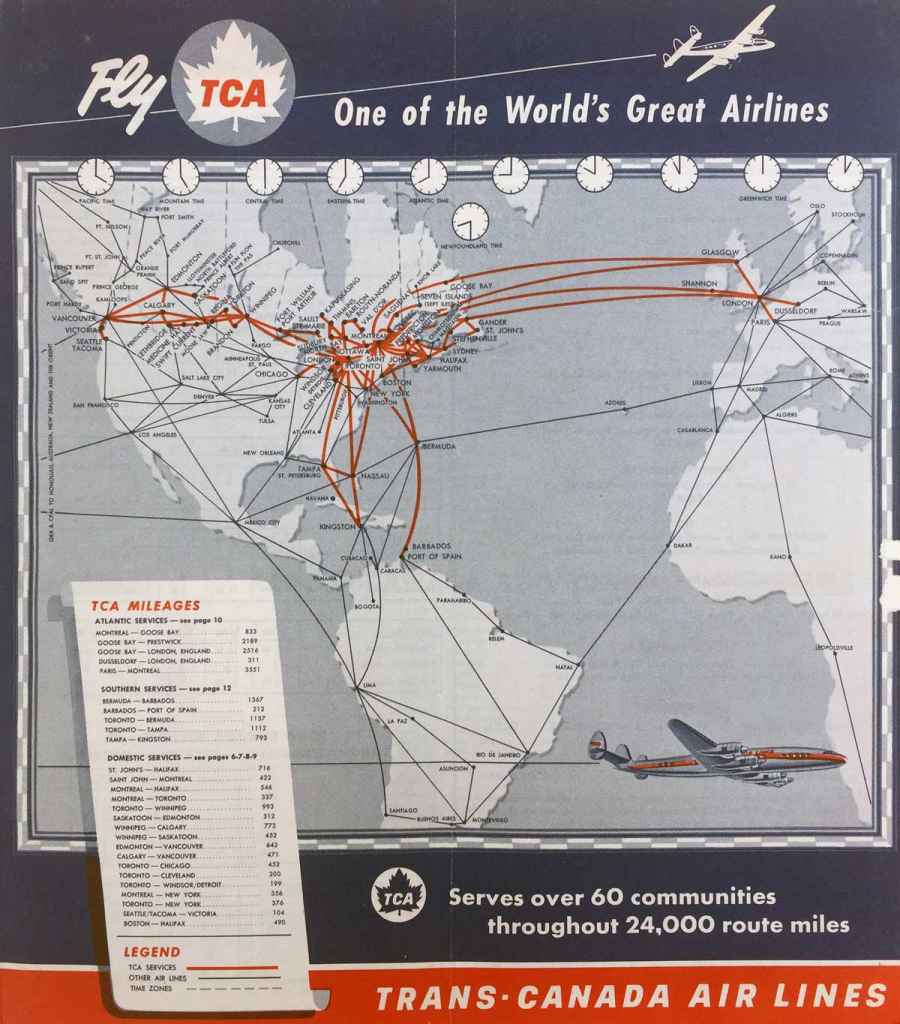
Trans Canada Air Lines 1956 route map, effective with the March 1 timetable. The prime yield airliner of the day was the Super Constellation.
In 1954, TCA began an air-freight service and in doing so, began to convert the DC-4M2s to all cargo versions by stripping interiors, plugging the windows and strengthening floors. To supplement their new-born freighter fleet of North Stars, TCA acquired several Bristol Mk. 31 Freighters. The Bristols and the North Stars were used on scheduled, all cargo flights between Montreal-Toronto-New York and Montreal-Toronto-Winnipeg. The Bristols were phased out in 1955 as enough DC-4M2s had been converted to freighters. It had also been discovered that the Bristols were not very profitable.
In 1955, TCA aroused a lot of interest in North America when they became the first airline on the continent to use the revolutionary turboprop powered Vickers Viscount 724. The Viscount had already made a name for itself in the European market and it soon became a favorite among North American travellers. The first of many routes to utilize the Viscount was the Montreal-Toronto-Winnipeg route in April of 1955. A few months later this aircraft was added to the New York route as well.
After experiencing tremendous success with the Viscount, both TCA and BEA hailed launch orders with Vickers for the Viscount’s new big brother, the Vanguard. In 1958, TCA placed the largest postwar industrial order in England with an order for a fleet of 23 Vanguard 952s, worth $67 million. The Vanguards were needed for routes too long for the Viscounts and too short for the new long range DC-8 jets. In 1959, radar equipment was installed in all aircraft. The fleet now consisted of 13 Super Constellations, 49 Viscounts, 31 North Stars and nine DC-3s. It was also in 1959 that TCA placed their order with Douglas for DC-8 aircraft.
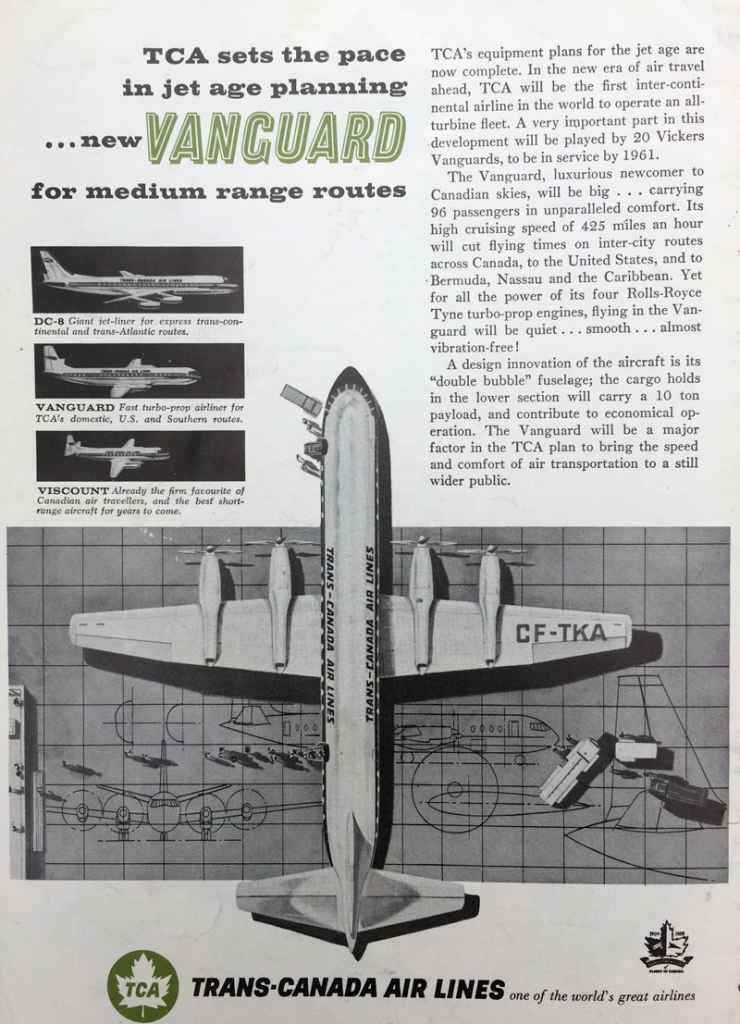
TCA Vanguard advert June 1959, boasting “TCA’s equipment plans for the jet age are now complete. In the new era of air travel ahead, TCA will be the first inter-continental airline in the world to operate an all-turbine fleet.” TCA had a standing order for 20 Vickers Vanguards to be inservice by 1961.
0n April the first, 1960, TCA became the first operator of the Conway powered DC-8-41. (The introduction of the DC-8 occurred 14 months before the first Vanguard entered service.) In June of 1960, the DC-8s began to fly the Montreal-London route, covering the distance in just six hours, compared with the Connie’s time of 11 hours. Douglas agreed to take most of TCA’s Connies in trade for DC-8s and the sun was now setting on the era of the piston powered airliner. 0n the 13th of June, 1961, the last North Star was retired.

The Douglas DC-8 was in service with Trans-Canada Air Lines effective June 15, 1960 “Across Canada – Across the Atlantic”.
Through the summer and well into the winter of 1960, Vanguard flight certification tests were still being carried out at Vickers in Weybridge (Surrey, UK) as severe turbine disk failures had been plaguing the engines. This led to a seven month delay in Vanguard deliveries. On February 1, 1961, the first Vanguard was delivered. This lead to the disposal of the DC-3s and Connies, which made TCA the first all turbine powered airline in North America.
In January of 1963, TCA placed an order for a DC-8F freighter, with the first one arriving in October. Then in 1964, in anticipation of a future Viscount replacement, an order was placed for eight Douglas DC-9-14s with Douglas. (Air Canada later upgraded to DC-9-30s.) The Douglas DC-9 was a medium range passenger jet that was designed to transport 100 passengers in jet comfort with jet economics.
Being Canada’s national flag carrier, it was felt that TCA’s colors and name did not accurately represent the country. It was decided to change the name to Air Canada. On 13 October, 1964, the first aircraft to wear Air Canada titles, (a DC-8), carried the Queen Mother from Ottawa to London. And on January 1, 1965, TCA officially became Air Canada. The name Air Canada is also bilingual.
By the following year Air Canada had 16 DC-8s, and the new baby DC-9s began taking over Viscount routes, operating with a 72 seat configuration. That same year also saw the opening of new cargo facilities in Vancouver and Toronto. In November, Air Canada also became the first North American airline to fly into the USSR (using DC-8 equipment) from Montreal via Copenhagen. In return, Aeroflot began service to eastern Canada.
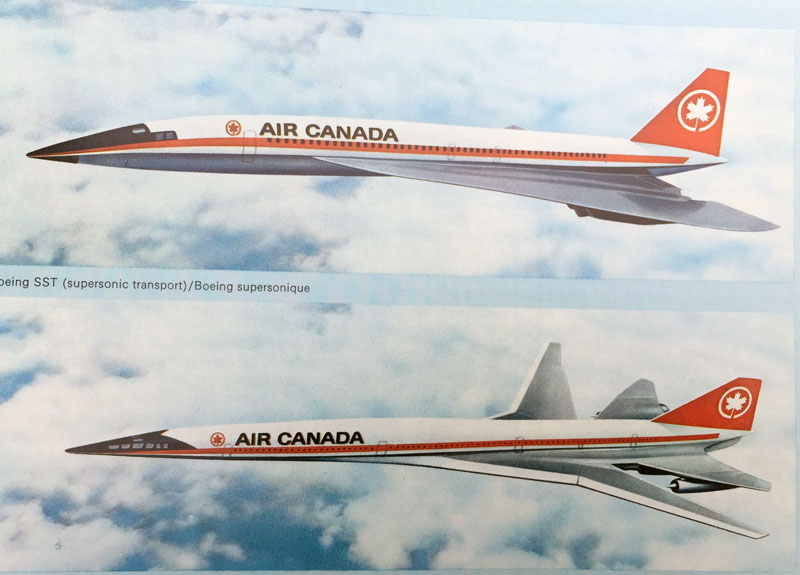
By the summer of 1967, Air Canada had placed orders for four Anglo-French Concordes with delivery in 1973, plus six Boeing SSTs for delivery in 1977. Neither aircraft was ever delivered to Air Canada. The Boeing SST never even flew.
Air Canada introduced the stretched DC-8-61/63 into their fleet in 1967 in Time for the Montreal Expo that summer. As the carrier entered the 1970s, they took delivery of their first Boeing 747 on 11 February, 1971. By ordering from Boeing, Air Canada broke a lifetime of patronizing only Douglas and Lockheed. The 747s were put into service on the 25th of April, 1971, supplementing the DC-8s on the Atlantic routes. With this fleet upgrading, all Air Canada’s Vanguards were phased out of passenger service and one aircraft was converted to a freighter. By late 1972, all the Vanguards had been retired with three scrapped in Montreal and the others all going to operators in the UK and France via Air Holdings, an aircraft broker. The Viscounts were still keeping up after 17 years of reliable service, but their days were numbered due to the arrival of the new DC-9-30s.
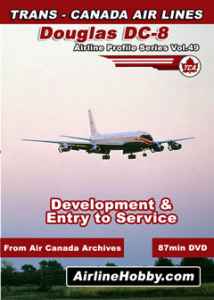 In 1972, Air Canada, following the general trend, cancelled all options on the Anglo-French Concord. By March of 1973, the Lockheed L-1011 Tristar had entered service, first flying the Toronto-Vancouver route. An era really came to an end for the airline in April of 1974 when the last of the fleet of 51 Vickers Viscounts was finally retired. All of the Viscounts were flown to Winnipeg for storage and to await sale, but not all were sold. To this very day, a few diehard Air Canada Viscounts still sit out in pasture awaiting the dreaded torch.
In 1972, Air Canada, following the general trend, cancelled all options on the Anglo-French Concord. By March of 1973, the Lockheed L-1011 Tristar had entered service, first flying the Toronto-Vancouver route. An era really came to an end for the airline in April of 1974 when the last of the fleet of 51 Vickers Viscounts was finally retired. All of the Viscounts were flown to Winnipeg for storage and to await sale, but not all were sold. To this very day, a few diehard Air Canada Viscounts still sit out in pasture awaiting the dreaded torch.
Air Canada was now an ail Jet airline. The winter of 1974 saw Air Canada introduce the Boeing 727-200 to its fleet (at first placed on the Toronto- Montreal Rapidair route). The Boeing 727 has proved itself to be one of the most valuable additions to Air Canada’s fleet and now forms the core of Air Canada’s North American route network. By the mid 1970s, Air Canada’s older DC-8s were being phased out and some were leased to Cubana and Air Jamaica. In 1977, Air Canada DC-8-43s CF-TJB and CF-TFC were scrapped.
To commemorate the airline’s 40th birthday in 1977, Air Canada re flew that first historic fiight from Vancouver to Seattle, only this time it was with their newest aircraft, a Boeing 727, occupied by the media and senior company executives. In late l977, early 1978, Air Canada made a small alteration in its paint scheme. The airline titles, which were previously painted black, now appeared in red lettering. The black anti-glare nose panel was removed and the red cheatlline was thickened and was continued around the nose of the aircraft.
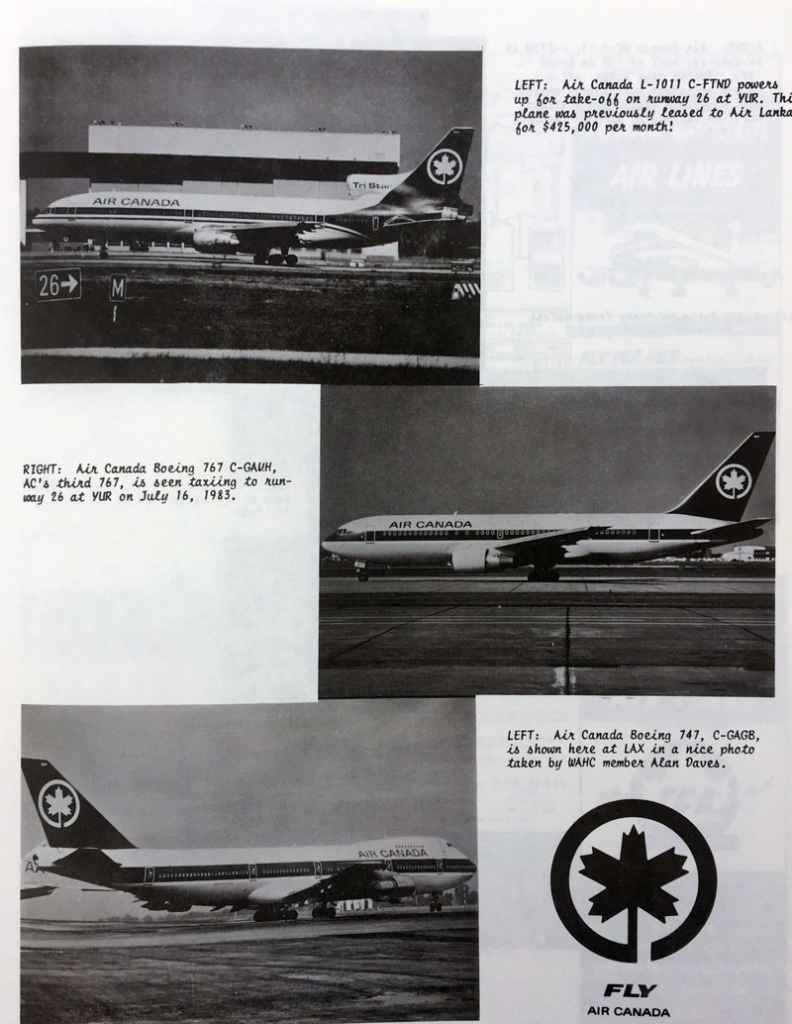
Photo page from the Captain’s Log, Spring 1984. The author was just 20 when this article was published, and this marked his very first time in print as a published writer.
With this exchange of shares, Air Canada’s equity was substantially increased, thus giving the company a much healthier debt/equity ratio. To the chagrin of CP Air, the government had improved Air Canada’s financial condition and at the same time, placed it in a stronger operating position than before. The airline would now be able to respond to any rapid changes in its environment which could be expected in the coming years.
The late 1970s brought about two very major realizations: The cargo industry was quickly growing and fleet modernization was of immediate importance. Air Canada’s general cargo revenues were growing at a rate of 25 percent per year and additional aircraft capacity was needed to help in the development of small package services. Three used Boeing 727-22 cargo jets were purchased from United Airlines in February of 1979, primarily to be used in the new small package service. It was also decided that five of the DC-8-63 passenger aircraft would be converted to pure main-deck freighters.
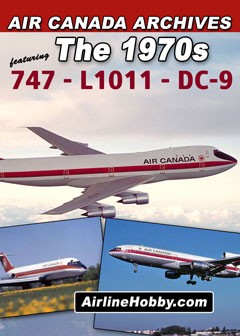 Back in 1979, Air Canada set an operational goal of keeping the passenger stretched DC-8s no longer than six years. A replacement would have to have a capacity of at least 200 passengers, have sufficient range to serve the medium and long range North American routes, and preferably have a twin aisle configuration. The Boeing new generation 767 was the plane chosen and twelve were ordered with options on 18 more. However, deliveries would not start until the spring of 1983. Until these new aircraft were on hand it was necessary to modernize the interiors of the DC-8s with the new wide body look, similar to the Boeing 727 interiors.
Back in 1979, Air Canada set an operational goal of keeping the passenger stretched DC-8s no longer than six years. A replacement would have to have a capacity of at least 200 passengers, have sufficient range to serve the medium and long range North American routes, and preferably have a twin aisle configuration. The Boeing new generation 767 was the plane chosen and twelve were ordered with options on 18 more. However, deliveries would not start until the spring of 1983. Until these new aircraft were on hand it was necessary to modernize the interiors of the DC-8s with the new wide body look, similar to the Boeing 727 interiors.
In the depth of the 1980 recession, Air Canada found that difficulties were arising in filling the seats of their 747s, particularly on the European routes. The answer to the problem was the Lockheed L-1011 (Lockheed once again) with its smaller number of seats and its over the pole range. The advanced L-1011-500 deliveries began in March of 1981. These aircraft were based in western Canada since they were going to be used on the western Canada to Europe routes.
In view of the success of Cammacorp’s CFM-56 re-engine program for the DC-8, Air Canada decided to get involved. In July of 1983, Air Canada decided to go ahead and have six of their DC-8-63AFs converted to the upgraded -73 series. Since that time Air Canada has signed an agreement with Cammacorp whereby Air Canada will perform their own conversions. Also, Cammacorp has licensed Air Canada to do contract work for other airlines at their Dorval maintenance base. The first DC-8 to be converted was C-FTlP which was ready for flight tests on November 23, 1983.
As planned, the stretched DC-8s were withdrawn from service before the six year deadline set in 1979 (by 1985). On April 23, 1983, all the stretched DC-8s flew their last passenger flights for Air Canada. Ali flights arrived at Toronto where the fleet was prepared for the ferry flight down to the Marana Airpark in Arizona.
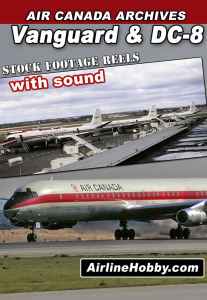 The aircraft will be stored there until it is decided what is to become of them. At the time of this printing, all the Air Canada DC-8s are still in open storage at Marana. There has been many stories as what will happen to these aircraft. If not sold there is talk they may go to the Canadian government to be used as Canadian Armed Forces military and V.I.P. transports to replace the Boeing 707s.
The aircraft will be stored there until it is decided what is to become of them. At the time of this printing, all the Air Canada DC-8s are still in open storage at Marana. There has been many stories as what will happen to these aircraft. If not sold there is talk they may go to the Canadian government to be used as Canadian Armed Forces military and V.I.P. transports to replace the Boeing 707s.
As for the future of Air Canada, it will be very unpredictable. At present, the Canadian Department of Transport is reviewing the possibility of creating an American-styled type of deregulation. Any type of deregulation would hurt Air Canada. As for equipment, the DC-8-73s will last until the 1990s. The carrier is expecting the last batch of six Boeing 767s from their first order this year. Two 747s are currently being leased (one to Air National and the other to Global). As for a DC-9 fleet replacement, requirements are under constant review and nothing has yet been decided. When asked to comment on Air Canada in the 1980s for this article, Air Canada’s Public Relations Coordinator R. Reid replied, ‘”I am really unable to comment with the economic situation so volatile.”
Tags: air canada, DC-4M2, DC-9, Dorval, Northstar, Trans-Canada, Vickers, Viscount
